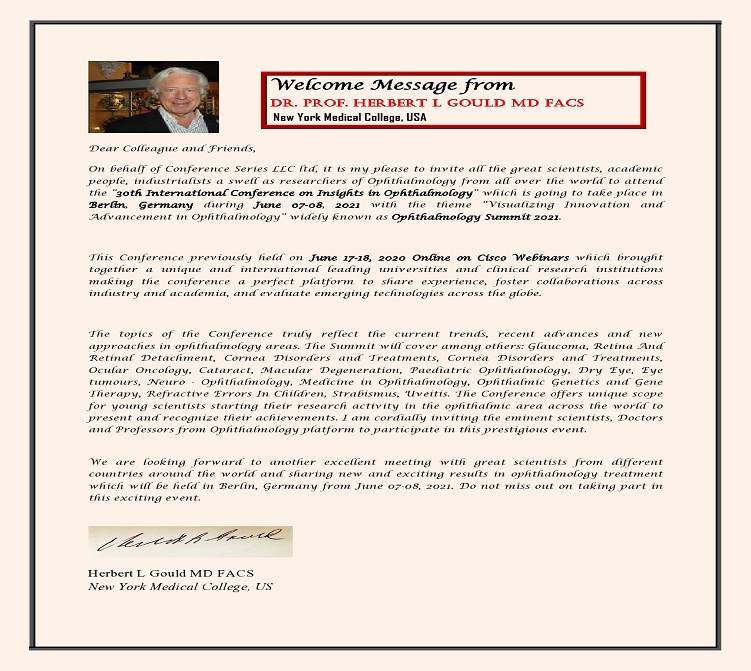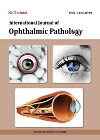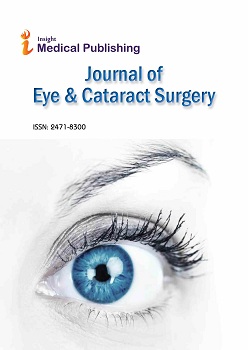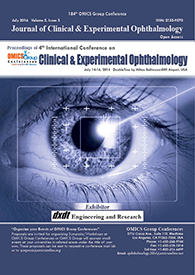Theme: Visualizing Innovation and Advancement in Ophthalmology
Ophthalmology Summit 2021
- Welcome Message
- About Conference
- Sessions & Tracks
- YRF(Young Research Forum)
- Market Analysis
- Learn more
- Participation Options and Benefits

30th International Conference on Insights in Ophthalmology
The world's largest Ophthalmology Conference and Gathering for the Research Community. Join the 30th International Conference on Insights in Ophthalmology which is going to be held during June 07-08, 2021 at Berlin, Germany. On behalf of the organizing committee, we hope you will join us for an exciting and stimulating meeting!
About
30th International Conference on Insights in Ophthalmology unites a one of a kind and universal blend of extensive and medium pharmaceutical, biotech and analytic organizations, driving colleges and clinical research establishments making the gathering an ideal stage to share involvement, cultivate joint efforts crosswise over industry and the scholarly world, and assess developing innovations over the globe.
Ophthalmology Summit 2021 augments the chance to interface with and gain from your associates from the nation over and over the globe it had with the discourses on Retina and Retinal Issue, Cornea ,Outside Eye Ailment , Neuro-Ophthalmology, Glaucoma: Visual Field Misfortune, Visual Microbiology and Immunology, Novel Ways to deal with Ophthalmology, Therapeutics and some more.
Objective
Our aim is to provide cataract surgeons, refractive surgeons, optometrists , opticians, young researchers, students, industrial delegates and anyone professionally involved in study of cataract and refractive surgery with an opportunity to learn about the complexity of the disease, discuss interventional procedures, look at new and advanced cataract removal practices and their efficiency and efficacy in the treatment of various refractive errors and cataract extraction, and understand local realities and practical constraints in improving vision-care.
About Organizers
Conference has an enhanced and highlighted features of scientific partnerships and alliances with development agencies, Institutes, leading research organizations, non-government organizations, and other entities to promote the development-oriented research across the globe through live streaming, B2B and Scientific Meetings. Medical Conferences provides an excellent opportunity for the budding scientists and young researchers through its special initiatives like Young Researcher Forum, Poster Presentation and E-poster.
Conference Highlights:
3. Retina And Retinal Detachment
4.Cornea Disorders and Treatments
6. Cataract
10.Eye tumours
14.Thyroid Eye Disease (TED or Graves Eye Disease)
15.Diagnostic & Therapeutic Instruments used in Optometry and Ophthalmology
17.Ophthalmic Genetics and Gene Therapy
18.Refractive Errors In Children
19.Strabismus
20.Uveitis
Target Audience
Ophthalmologists, Optometrists, Opticians, Doctors, Researchers, Students, Industrial Delegates from Academia and Research along with the industrial professionals from biomedical companies and healthcare sectors.
·Clinical researchers & Scientists
.Medical Practitioners, Professors, Deans, Students & Technicians
.Medical & Health care Organizations & Associations
.Idiopathic Intracranial Hypertension – Ocular Migra
Diagnostic Instruments in Optometry
Young Scientist Benefits
- Our conferences provide best Platform for your research through oral presentations.
- Share the ideas with both eminent researchers and mentors.
- Young Scientist Award reorganization certificate and memento to the winners
- Young Scientists will get appropriate and timely information by this Forum.
- Platform for collaboration among young researchers for better development
- Award should motivate participants to strive to realize their full potential which could in turn be beneficial to the field as whole
Sessions & Tracks
Track 1: Ophthalmology
Ophthalmology is that the specialty involved with the medical and surgical care of the eye. Ophthalmologists are experts in medical treatment, surgery and microsurgery for eye conditions and diseases in addition to diagnosing systemic disease that manifest in eye signs or symptoms. Ophthalmology has many subspecialties.
Aao 2019 Annual Meeting | 12-15 October 2019 |California, United States; World Cornea Congress Viii | 13–15 May 2021 | Boston,United States; World Ophthalmology Congress 2021 - Woc2021 | 26-29 June 2021 | Cape Town, South Africa; Aao 2021 Annual Meeting |14-17 November 2021 | Las Vegas, United States
Track 2: Glaucoma: A Vision Loss
Glaucoma is a social event of related eye issue that reason mischief to the optic nerve that passes on information from the eye to the cerebrum. In its starting periods, glaucoma has no reactions, which is what makes it so dangerous when you see issues with your sight, the disease has progressed to the point that irreversible vision and might.
- Open angle Glaucoma
- Angle-closure Glaucoma
- Laser Trabeculoplasty
- Trabeculectomy
- Viscocanolostomy
- Surgical Implants for Glaucoma
Track 3: Retina and Retinal Detachment
The retina is a slight layer of tissue within back mass of eye. It contains a large number of light delicate cells and other nerve cells that get and compose visual data. Retina sends this data to cerebrum through optic nerve, empowering to see. Retinal degenerative issue, for example, Age-related macular degeneration and near-sighted macular degeneration influencing youthful and old from numerous societies, races and ethnicities. The focal zone of the retina contains a thickness of shading delicate photoreceptor cells called cones which are in charge of shading vision and thus any deformity and modification in the focal territory of the retina will prompt colour vision imperfections ailments like diabetic retinopathy and retinal tumours can likewise be in charge of the lasting vision misfortune in the event. Retinal malady has a low need in avoidance of visual deficiency programs in creating nations. There are a few purposes behind this; it was suspected that retinal sickness was a remarkable reason for visual deficiency in the creating scene and that the gear required was too expensive and temperamental for use in a creating nation environment. At last, there is an absence of talented faculty with sub-forte preparing in retinal sickness.
- Bulging Eyes
- Cataracts
- CMV Retinitis
- Colour Blindness
- Crossed Eyes (Strabismus)
- Diabetic Macular Edema
- Retinal Detachment
- Colour vision defects
Track 4: Cornea Disorders and Treatments
Eye is composed of very sensitive and fragile tissues and every part of an eye serves its own function to maintain its normal vision. The cornea is the transparent front part of the eye that covers the iris, pupil, and anterior chamber. The Cornea, with the anterior chamber and lens, refracts light, with the cornea accounting for approximately two-thirds of the eye’s total optical power. But factors such as corneal ulceration, epithelial keratitis & drug-induced epithelial keratitis, corneal regeneration, recurrent corneal erosion and miscellaneous corneal disorders can affect the cornea and ultimately lead to the external eye disease that could end up with permanent blindness. Hence investigation of corneal disease is carryout to mitigate the disease and methods like Contact lenses & vision correction is also use to cure the vision related problems and surgical procedure like corneal transplantation is used to transplant the cornea. The cornea and focal point of the eye are worked to concentrate light on the retina, which is the light-touchy tissue at the back of the eye. At the point when light strikes the cornea, it twists or refracts the light approaching onto the focal point. The focal point refocuses that light onto the retina, which begins the interpretation of light into vision. The retina changes over light into electrical driving forces that go through the optic nerve to the mind, which translates them as pictures.
Track 5: Ocular Oncology
As ocular oncology is a highly specialized field of ophthalmology, there is active international collaboration between ocular oncologists. Ocular oncology is a multidisciplinary service which includes general oncologists, paediatric oncologists, specialist nurses, clinical scientists and many others. The most common malignancies include uveal and conjunctivitis melanoma, uveal metastasis, intraocular and conjunctiva lymphoma and conjunctiva carcinoma. As well as the management of confirmed malignant tumors, ocular oncologists receive a large number of referrals of patients with suspected malignant tumours. Diagnosis is based on bio microscopy, ultrasonography, angiography, optical coherence tomography, auto fluorescence imaging and biopsy. The most common benign tumors include naive, chordal haemangioma . Many of these lesions require treatment and/or long-term surveillance. Eyelid and orbital tumors are more likely to be managed within oculoplastic or orbital specialist services.
- Anisocoria
- Lagophthalmos
- Night blindness
- Uveitis
- Macular degeneration
- Heterochromia iridis
- Hyphema
- Aniridia
- Iridodialysis
Track 6: Cataract
Cloudy area that structures in the eye’s basic focal point is known as Cataract. It makes at bit by bit and at last starts intruding with the vision. People may end up with Cataracts in the two eyes, yet they generally don’t shape meanwhile. Waterfall is an incredibly typical subject to be discussed in the Ophthalmology Conferences. Waterfall is one of the consistent afflictions in more prepared people.50% of the masses in the United States and Europe have waterfalls and have transformed into the most generally perceived reason of vision incident on the planet. As a rule, the finding of a waterfall is genuinely basic. Be that as it may, in the pre-birth populace, in spite of the fact that analysis is conceivable it is more troublesome. Ultrasounds have demonstrated a compelling strategy to distinguish waterfalls in unborn youngsters. It is basic that they be identified early if present as waterfalls in infants can bring about visual impairment forever if not treated legitimately and rapidly not long after birth. Late examinations demonstrate that the frequency of waterfalls is significantly higher contrasted with that of diabetic retinopathy and Glaucoma. It has turned into the most widely recognized malady in maturing grown-ups and ends up being an unavoidable backup amid seniority.
Track 7: Macular Degeneration
Macular Degeneration is caused by the deterioration of the central portion of the membrane, the within back layer of the attention that records the pictures we see and sends them via the cranial nerve from the attention to the brain. The retina’s central portion, referred to as the macula, is chargeable for focusing vision within the eye, and it controls our ability to scan, drive a automobile, acknowledge faces or colors, and see objects in fine detail. Degeneration is that the cause area unit advanced, however embody each heredity and setting. Dry degeneration is diagnosed once when yellowish spots referred to as drusen begin to accumulate in and round the macula. It's believed these spots area unit deposits or scrap from deteriorating tissue.
Age-related degeneration typically produces a slow, painless loss of vision. In rare cases, however, vision losses are often sharp. Early signs of vision loss from AMD embody shadowy areas in your vision or outstandingly fuzzy or distorted vision. Treatments for degeneration rely upon whether or not the malady is in its early-stage, dry type or within the additional advanced, wet type that may result in serious vision loss. No FDA-approved treatments exist yet for dry macular degeneration, though biological process intervention might facilitate stop its progression to the wet type.
Track 8: Paediatric Ophthalmology
Paediatric Ophthalmology refers to the diagnosis and treatment of eye disorders, especially in children. The scope for research in this field is high because the treatment modalities and protocols differ entirely from that of the elderly. The diseases affecting the paediatric vision includes Genetic eye diseases, paediatric uveitis, developmental abnormalities and more. There are many genetic diseases that need at most concern during the early stage. Amblyopia is a disease which happens because of the reduced vision in an eye which hasn’t received adequate use during early childhood. The symptoms include tilting the head, poor depth perception and improper movements of the eye.
- Retinopathy of prematurity
- Orbital Trauma
- Paediatric Cataract
- Paediatric Glaucoma
- Paediatric Optometry
- Paediatric Vision Care
- Childhood Malignancies
- Congenital Cataract
Track 9: Dry Eye & Low Vision
Dry eye is a condition wherein an individual needs more quality tears to grease up and support the eye. Tears are essential for keeping up the soundness of the front surface of the eye and for giving clear vision. Dry eye is a typical and frequently endless issue, especially in more established grown-ups. And low visual observation which intrudes the step by step working of a tyke or Low vision as the name exhibits the condition associated with surprising.
- Optic and Radiations
- Optical Power of the Eye
- Optic Nerve Disease
- Spectacle Lens
- Contact Lens
- Biophysics of vision
- Stereopsis: 3D Vision
Track 10: Eye tumours
Tumours in the eye usually are secondary tumours caused by cancers that have spread from other parts of the body, especially the breast, lung, bowel or prostate. Two types of primary tumors arise within the eye itself and are known as retinoblastoma in children and melanoma in adults.
Retinoblastoma is a cancer of the retina, the eye's light-sensitive tissue. This most common childhood eye cancer usually strikes children under age five, affecting 500 to 600 in the United States each year. In nearly a third of the cases, retinoblastoma occurs in both eyes. While symptoms are not evident early in the disease, increasing pain and vision loss eventually signal the problem.
Malignant melanoma occurs most frequently in adults 60 to 65 years of age, arising from uncontrolled growth of cells called melanocytes. From 1,500 to 2,000 new cases are diagnosed annually in the United States.
Track 11: Neuro - Ophthalmology
Neuro-Ophthalmology is the consolidation of neurology and ophthalmology, frequently managing complex systemic sicknesses that have signs in the visual framework. Cerebral Visual Impairment (CVI) incorporates every single visual brokenness created by harm to, or breaking down of, the retrochiasmatic visual pathways without harm to the foremost visual pathways or any significant visual ailment. Vision problems can be described as the decreased ability to view things. There are many varieties of eye problems and vision disturbances, myopia, halos, blurred vision etc. The impaired vision or vision problems will reduce the sharpness of images. It usually hampers the daily activities of a person. Myasthenia gravis is brought about by a breakdown in the typical correspondence in the middle of nerves and muscles which prompts twofold vision, hanging eyelids and different muscles shortcoming which affecting the both i.e. neuromuscular action furthermore vision. Demonstrative instruments in Neuro-ophthalmology are utilized to explore and to treat the different state of Neuro-ophthalmology as Neonatal visual examination are basically performed to screen the vicinity and movement of Retinopathy of Prematurity. College of Pennsylvania is presently taking a shot at Neuro-ophthalmology venture. Treatment of Neuro Ophthalmology will rely upon one’s analysis and furthermore contain medicinal treatments, botulinum poison infusions to stop muscle fit for disarranges, for example, hemifacial fit, laser surgery for various vision issue and surgical medications, as for eye muscle surgery to reestablish straight eye arrangement.
Track 12: Ophthalmology surgery
Ophthalmic surgery also known as ocular surgery is performed in the eye to treat a condition or a disease by an ophthalmologist. There are many types of ophthalmic surgery which includes corrective surgery-which is used to correct or treat a disorder. Phacoemulsification is a cataract surgery in which the internal lens in the eye is modified. Glaucoma surgery is done to decrease the production of intraocular fluid. Orbital surgery is especially considered with the eyelids or orbit and the lacrimal system.
- Orbital decompression surgery
- Tear duct surgery
- Refractive surgery
- Vision Correction Surgery
- Retinal Replacement Surgery
- Retinal Detachment Surgery
- Cataract Surgery
- Plastic Surgery
- Glaucoma Surgery
Track 13: Diabetic Retinopathy
Diabetic retinopathy is a diabetes complexity that influences eyes. It’s caused by harm to the veins of the light-touchy tissue at the back of the eye (retina). At initially, diabetic retinopathy may cause no side effects or just gentle vision issues. In the end, it can cause visual deficiency.
- Early diabetic retinopathy
- Advanced diabetic retinopathy
Track 14: Thyroid Eye Disease (TED or Graves Eye Disease
Graves' eye disease, also known as thyroid eye disease, is an autoimmune condition in which immune cells attack the thyroid gland which responds by secreting an excess amount of thyroid hormone. As a result, the thyroid gland enlarges and excess hormones increase metabolism. The hypermetabolic state is characterized by fast pulse/heartbeat, palpitations, profuse sweating, high blood pressure, irritability, fatigue, weight loss, heat intolerance, and loss of hair and alterations in hair quality. When the immune system attacks the tissues around the eyes, it causes the eye muscles or fat to expand.
The eyes are particularly vulnerable to Graves' eye disease, because the autoimmune attack often targets the eye muscles and connective tissue within the eye socket. This likely occurs because these tissues contain proteins that appear similar to the immune system as those of the thyroid gland. Ocular symptoms can range from mild to severe; but only 10-20% of patients have sight threatening disease. Another tissue that can also be involved in the immune attack of Graves' eye disease is the skin of the shins.
In Graves’ eye disease the tissue around the eye is attacked, and the result is inflammation and swelling, causing:
- Redness and pain
- Puffiness around the eyes
- Bulging of the eyes
- Dry eye and irritation, occurring when the eyelids cannot close completely over bulging eyes
Track 15: Diagnostic & Therapeutic Instruments used in Optometry and Ophthalmology
Diagnostic and therapeutic equipment help in diagnosing a disease and in treating it. Ophthalmic instruments are prototyped to prevent eye damage, injuries. A modern-day optometric practice use cutting-edge techniques, delivers the best quality service and provide customer satisfaction.
Track 16: Medicine in Ophthalmology
Medical ophthalmologists are doctors trained in both general (internal) medicine and ophthalmology. They manage medical eye disorders, many of which are related to systemic (ie whole-body) disease such as diabetes, hypertension, atherosclerosis, inflammation, infection and malignancy. Ocular inflammatory disorders may be the first manifestation of systemic disease and it is important that the whole patient is investigated and treated, not just the presenting organ. Their role is different from ophthalmic surgeons who are specialists in the surgical and medical treatment of diseases and injuries in and around the eye.
Medical ophthalmologists treat conditions such as:
- inflammatory/infectious disorders affecting vision, eg uveitis, scleritis, corneal graft rejection, systemic vasculitis, thyroid eye disease
- neurological disorders affecting vision, eg multiple sclerosis, brain tumour, stroke, pituitary disorders, thyroid eye disease,
- raised eye pressure, eg glaucoma
- retina specific disorders affecting vision, eg age-related macular degeneration
- vascular disorders affecting vision, eg diabetes, diabetic retinopathy,
- genetic disorders affecting vision, eg retinitis pigmentosa.
Track 17: Ophthalmic Genetics and Gene Therapy
Gene therapy is an exploratory technique that employs genes to treat or prevent diseases. In near future, this technique may include a doctor replacing the mutated gene with a healthy copy of the gene to the patient in order to cure the abnormalities instead of surgery or drugs. Ophthalmic genetics is a branch of ophthalmology which refers to the field where the genetic background of disease is researched. Leber Congenital Amaraius(LCA) is a hereditary genetic disease that causes childhood blindness. Scientists and doctors have treated this disease with the help of gene therapy.
- Genetics of Myopia Development
- Gene Therapy
- Usher syndrome
- Familial exudative vitreal retinopathy
- Retinoblastoma
- Leber hereditary optic neuropathy (LHON)
- Optic atrophy
- Genetics of Myopia Development
Track 18: Refractive Errors in children
Refractive mistakes are only one potential reason for obscured vision, so it is critical for your kid to have an examination immediately in the event that they are encountering side effects.
The most well-known refractive mistakes in youngsters are:
- Myopia (otherwise called near-sightedness)
- Hyperopia (additionally called farsightedness)
- Astigmatism (contorted vision)
It is conceivable to have at least two kinds of refractive mistake in the meantime.
Near-sightedness: A near-sighted eye is longer than ordinary or has a cornea that is excessively steep, with the goal that the light beams center before the retina. Close protests look clear, however removed items seem obscured.
Hyperopia: A hyperopic eye is shorter than typical. Light from close protests can't center obviously around the retina. The words on a page will appear to be hazy, or it will be hard to see all around ok to do quit for the day, such as threading a needle.
Astigmatism: Astigmatism contorts or obscures vision for both close and far items. It's relatively similar to investigating a fun house reflects in which you show up excessively tall, too wide or too thin. A typical cornea is round and smooth, similar to a ball. It is conceivable to have astigmatism in blend with near-sightedness or hyperopia.
- Conjunctivitis
- Styes
- Genetic cornea disease
Track 19: Strabismus
Strabismus is a failure of the two eyes to maintain proper alignment and work together as a team. One eye turns inwards, upwards, downwards, or outwards, while the other one focuses at one spot. This typically happens as a result of the muscles that management the movement of the attention and therefore the protective fold, the extra ocular muscles, aren't operating along.
There are different types of strabismus
- Hypertropia is once the eye turns upwards
- Hypertropiais once the eye turns downwardly
- Esotropia is once the eye turns inwards
- Exotropia is once the eye turns outward.
Track 20: Uveitis
Uveitis could be a form of inflammation to the center layer of the attention (uvea), structure typically contains the iris, membrane and choroid coat. The causes of uveitis area unit of various varieties starting from a straightforward microorganism Infection to severe eye injury, studies show that the presence of inflammatory disease, AIDS, skin condition will increase the probabilities of uveitis. during this the inner a part of the attention turns to red in color, thanks to this pain, blurred vision and picture sensitivity happens. Prompt use of anti-bacterial will treat the condition otherwise their area unit high probabilities that it should cause eye disease, cataract etc...
Track 21: Optical Imaging and Sensing:
Optical Imaging is the method in which light is being used to get the investigational imaging of the medical operations. Basically, optical imaging is of two types which are diffusive Imaging systems and ballistic imaging system. Some of the main examples are scanning laser ophthalmoscopy, optical coherence tomography, optical microscopy and endoscopy, spectroscopy.
- Digital Optics for Immersive Displays
- Unconventional Optical Imaging
- Optical Micro- and Nano metrology
- Optical Sensing and Detection
- Imaging in Biology and Medicine
Track 22: Optical Technologies and Laser Science in Ophthalmology
Light, like radio, consists of electromagnetic waves. The major difference between the two is that light waves are much shorter than radio waves. The use of electromagnetic waves for long-distance communications was the beginning of an industry known first as wireless and later as radio. This industry was the foundation for electronics, which brought the world so many fascinating technologies. The word LASER stands for Light Amplification by Stimulated Emission of Radiation. A laser is a device that emits a concentrated beam of photons, which are the basic units of electromagnetic radiation.
- Optical Metrology
- Laser Technology
- Biophotonics
- Optical fiber technology
- Electromagnetic waves
- Technical Optics and Automotive Lighting
Track 23: EYE FLOATERS:
EYE FLOATERS are spots in your vision. ... Most are caused by age-related changes that occur as the jelly-like substance (vitreous) inside you becomes more liquid. Microscopic fibers within the vitreous tend to clump and can cast tiny shadows on your retina. The shadows you see are called floaters
Track 24: Age Related Eye Disease (AREDS):
The Age-Related Eye Disease Study (AREDS) is a major clinical trial sponsored by the National Eye Institute, one of the federal government's National Institutes of Health. The AREDS was designed to learn more about the natural history and risk factors of age-related macular degeneration (AMD) and cataract and to evaluate the effect of high doses of vitamin C, vitamin E, beta-carotene and zinc on the progression of AMD and cataract. Results from the AREDS showed that high levels of antioxidants and zinc significantly reduce the risk of advanced AMD and its associated vision loss. These same nutrients had no significant effect on the development or progression of cataract.
Track 25: Conjunctivitis:
Conjunctivitis, or pink eye, is an irritation or inflammation of the conjunctiva, which covers the white part of the eyeball. It can be caused by allergies or a bacterial or viral infection. Conjunctivitis can be extremely contagious and is spread by contact with eye secretions from someone who is infected.
Symptoms include redness, itching and tearing of the eyes. It can also lead to discharge or crusting around the eyes.
It's important to stop wearing contact lenses whilst affected by conjunctivitis. It often resolves on its own, but treatment can speed the recovery process. Allergic conjunctivitis can be treated with antihistamines. Bacterial conjunctivitis can be treated with antibiotic eye drops.
How it spreads
- By skin-to-skin contact (handshakes or hugs).
- By touching a contaminated surface (blanket or doorknob)
Prestigious Award for Young Research’s at Ophthalmology Summit 2021 –
“Visualization Innovation and Advancement in Ophthalmology”
Ophthalmology Summit 2021 Committee is glad to announce “30th International Conference on Insights in Ophthalmology” on June 07-08, 2021 in Berlin, Germany and focusing on the theme: “Visualization Innovation and advancement in Ophthalmology”. Ophthalmology Summit 2021 developments are maintaining their momentum. Ophthalmology Conference program delves into strategic discussions.
Ophthalmology Summit 2021 Young Scientist Awards:
Ophthalmology Summit 2021 Committee is intended to honour prestigious award for talented Young researchers, scientists, Young Investigators, Post-Graduate students, Post-doctoral fellows, Trainees, Junior faculty in recognition of their outstanding contribution towards the conference theme. The Young Scientist Awards make every effort in providing a strong professional development opportunity for early career academicians by meeting experts to exchange and share their experiences on all aspects of Cardiology.
Young Research’s Awards at Ophthalmology Summit 2021 for the Nomination: Young Researcher Forum - Outstanding Masters/Ph.D./Post Doctorate thesis work Presentation, only 25 presentations acceptable at the Ophthalmology Summit 2021 young research forum.
Benefits
- Young Scientist Award recognition certificate and memento to the winners.
- Our conferences provide best Platform for your research through oral presentations.
- Learn about career improvement with all the latest technologies by networking.
- Young Scientists will get appropriate and timely information by this Forum.
- Platform for collaboration among young researchers for better development.
- Provide an opportunity for research interaction and established senior investigators across the globe in the field.
- Share the ideas with both eminent researchers and mentors.
- It’s a great privilege for young researchers to learn about the research areas for expanding their research knowledge.
Eligibility
- Young Investigators, Post-Graduate students, Post-doctoral fellows, Trainees, Junior faculty with a minimum of 5 years of research experience
- Presentation must be into scientific sessions of the conference.
- Each Young Researcher / Young Scientist can submit only one paper (as first author or co-author).
- Age limit-Under 35yrs
- All submissions must be in English.
According to a study it is estimated that around 48% of world population is blind because of cataract and more than 60 million people suffer from glaucoma and it is estimated that the number would rise to 80 million by the end of 2021. Ageing population is the leading cause for refractive error problem in countries like the USA and Europe, it is noticed that the refractive error problem is mostly seen in population ageing more than 40 years.
After a huge downfall of the market during economic drain in 2008-2009, ophthalmology market is catching up to get back to the normal as there is a rapid growth in population resulting in increased number of patients with eye diseases and the incidence of cataract and glaucoma are increasing every year.
Importance and scope:
The field of Ophthalmology: Ocular treatment & care is growing rapidly and its development is making tremendous impacts in medical and health sciences and pharmaceuticals. The importance and significance can be gauged by the fact that it has made huge advancements over the course of time and is continuing to influence various sectors. Ophthalmology Congress 2021 conference will concentrate on latest and exciting innovations in areas of eye surgeries, diagnostics and recent technologies towards eye care. It will also provide an excellent opportunity to meet the leading eye surgeons, top class eye care specialists, ophthalmologists, optometrists, research scientists and the young student research community working the related field. Ophthalmology Congress 2021 Conference is designed to comprise of Keynote sessions, Workshops and focused symposium on latest developments in the field of one of the sense organ Eye health. The three-day Ophthalmology -2021 conference includes major sessions on detailed overview on Retinal diseases and disorders, Research Trends in Surgical and Medical Ophthalmology, Novel Approaches to Ophthalmology Therapeutics, Ocular-Pathology, Optometry and vision science. Ophthalmology Summit 2021 also acts as a platform to exchange information, new interventions and strengthen the collaboration among Ophthalmologists, Optometrists, Researchers, Associate Professors, and Scholars from both academia and ophthalmic Institutes.
According to WHO:
- 285 million people are estimated to be visually impaired worldwide: 39 million are blind and 246 have low vision.
- About 90% of the world’s visually impaired live in low-income settings.
- 82% of people living with blindness are aged 50 and above.
- Globally, uncorrected refractive errors are the main cause of moderate and severe visual impairment; cataracts remain the leading cause of blindness in middle- and low-income countries.
- The number of people visually impaired from infectious diseases has reduced in the last 20 years according to global estimates work.
- 80% of all visual impairment can be prevented or cured.
- Cataract removal is the most commonly performed ophthalmic surgical operation.
SIFI
SIFI is the leading Italian ophthalmic company, focused on eye care since 1935. SIFI designs, manufactures and markets innovative pharmaceutical specialty products, surgical and medical devices. Headquartered in Catania, Sicily, SIFI operates directly in Italy, Romania and Mexico with a staff of more than 350 people worldwide. Since June 2015, SIFI is backed by 21 Investment, a private equity firm founded by Alessandro Benetton, which supports the company’s international expansion and portfolio development strategy.
Fund Allotment to Ophthalmology Treatments and Research: The Ophthalmology Department at Upstate Medical University has received a $110,000 unrestricted grant from Research to Prevent Blindness (RPB), bringing the department’s total amount of RPB funding to more than $2.6 million since 1998. In addition to RPB funding, Upstage’s Ophthalmology Department has attracted more than $22.7 million in peer-reviewed funding from the National Institutes of Health, National Science Foundation and other agencies and lists among its funding sources $1.2 million from the Grateful Patient campaign of the Upstate Medical University Foundation and $250,000 from the Lions Clubs of District
The NEI is operating under a continuing resolution (H. R. 2775/Public Law 113-46), which provides $195M to fund operations. See http://grants.nih.gov/grants/guide/notice-files/NOT-OD-14-012.html. $10M is allocated to Research Management Support, $24M to the Intramural Research Program, and $161M to Extramural Research.
World Ophthalmology 2021 statistical surveying:
After a tremendous destruction of the market amid monetary deplete in 2010-2013, ophthalmology showcase is making up for lost time to return to the typical as there is a quick development in populace bringing about expanded number of patients with eye sicknesses and the occurrence of waterfall and glaucoma are expanding each year.
As indicated by an examination it is evaluated that around 48% of total populace is visually impaired due to waterfall and in excess of 60 million individuals experience the ill effects of glaucoma and it is assessed that the number would ascend to 80 million before the finish of 2021. Maturing populace is the main source for refractive blunder issue in nations like the USA and Europe, it is seen that the refractive mistake issue is for the most part found in populace maturing over 40 years.
Ophthalmology advertise is primarily separated in to four fragments viz, surgical gadgets, demonstrative and checking gadgets, vision mind and ophthalmic medications.
Academic research and industrial innovations, involving every aspect of cataract and refractive surgery techniques. However, it is open to all types of advanced research methodologies both from academia and industry
Significance and extension:
Ophthalmology Summit 2021 upgrades ophthalmic instruction to enhance eye mind Foundations like (NIE, Wilmer are included) Add to protection and rebuilding of vision around the globe.
Ophthalmology keeps on being an appealing field of solution with awesome openings.
Conference Series welcomes all the ophthalmologists, optometrists, research scholars, industrial professionals and student delegates from biomedical and healthcare sectors to be a part of the esteemed Ophthalmology Summit 2021.
Statistics of Physicians, Researchers and Academicians working on ophthalmology.
Eye Diseas world wide basis:
Globally, it is estimated that at least 2.2 billion people have a vision impairment or blindness, of whom at least 1 billion have a vision impairment that could have been prevented or has yet to be addressed .This 1 billion people includes those with moderate or severe distance vision impairment or blindness due to unaddressed refractive error (123.7 million), cataract (65.2 million), glaucoma (6.9 million), corneal opacities (4.2 million), diabetic retinopathy (3 million), and trachoma (2 million), as well as near vision impairment caused by unaddressed presbyopia (826 million) (1).
In terms of regional differences, the prevalence of distance vision impairment in low- and middle-income regions is estimated to be four times higher than in high-income regions (1). With regards to near vision, rates of unaddressed near vision impairment are estimated to be greater than 80% in western, eastern and central sub-Saharan Africa, while comparative rates in high-income regions of North America, Australasia, Western Europe, and of Asia-Pacific are reported to be lower than 10% (2).Population growth and ageing will increase the risk that more people acquire vision impairment.
Global Distribution:
Changing trends in diet and lifestyle as well as increased long life are growing the market for ophthalmological treatments: the global ophthalmic device market is expected to reach $28 billion by 2016 exhibiting a 2.5% compound annual growth rate from 2009 to 2016, according to GBI Research.
“The worldwide ophthalmic products market beats $22 billion (US) and is rising at more than 10% per year. Without the supplement of consumer eye care products, the ophthalmic products market is coarsely a $17 billion market.” Rising of call for ophthalmic devices and increasing healthcare coverage in emerging economies will rise sales to 2024.The medical device market of Japan is mainly comprised of medical equipment’s such as consumables, orthopaedic devices, dental devices, respiratory devices, and ophthalmic devices which are manufactured in Germany, France, the UK, Italy and Spain. The demand for medical devices has been increasing owing to a growing awareness for early diagnosis and treatment of uncountable disease states in Japan. The key countries that have contributed significantly in developing medical devices market during 2008-2013 include Germany, UK, Spain and France. Germany is one of the chief medical instrument development markets and it has been observed that the country contributes immensely to the exports of medical devices.
Overall No. of Ophthalmologists
According to the statistics provided by ICO there are app 60-70 ophthalmologists in London and more than 13000 ophthalmologists in U.K and 200000 estimated ophthalmologists worldwide. Among them 60% of ophthalmologist are into surgery and in U.K alone 50% of ophthalmologists are into surgery and around 1000 ophthalmologists are residence.
Progress in Retinal and Eye Research |American Journal of Ophthalmology | Journal of Refractive Surgery | British Journal of Ophthalmology | Journal of Cataract and Refractive Surgery | Journal of Vision | Ophthalmic Surgery Lasers and Imaging Retina | Japanese Journal of Ophthalmology | Canadian Journal of Ophthalmology | Current Eye Research | Journal of Ophthalmic Inflammation and Infection | Journal of Neuro-Ophthalmology | Journal of Ocular Pharmacology and Therapeutics | European Journal of Ophthalmology | International Journal of Ophthalmology | Ophthalmic Plastic and Reconstructive Surgery | Saudi Journal of Ophthalmology | Ocular Immunology and Inflammation | Indian Journal of Ophthalmology | International Ophthalmology | Open Ophthalmology Journal | Journal of Ophthalmic and Vision Research | Asia-Pacific Journal of Ophthalmology | Middle East African Journal of Ophthalmology | Taiwan Journal of Ophthalmology | Journal of Current Ophthalmology | Neuro-Ophthalmology Japan | Asian Journal of Ophthalmology | Journal of Clinical & Experimental Ophthalmology | Journal of Ophthalmology An Open Access | Journal Progress in Retinal and Eye Research | American Journal of Ophthalmology | Journal of Refractive Surgery | Investigative Ophthalmology and Visual Science | British Journal of Ophthalmology | Optometry: Open Access | Glaucoma: Open Access | Survey of Ophthalmology | Journal of Eye & Cataract Refractive Surgery | International Journal of Ophthalmic Pathology | CME Journal Ophthalmology |
Related Societies:
Ophthalmology Societies | Glaucoma Societies | Cornea Societies | Ocular Societies | Cataract Societies | Uveitis Societies | Optometric Associations
USA Societies:
Alabama Academy of Ophthalmology | American Society of Retina Specialists (ASRS) | American Association for Pediatric Ophthalmology and Strabismus | American Association of Ophthalmic Oncologists and Pathologists (AAOOP) | American Glaucoma Society| American Ophthalmological Society| American Society of Cataract and Refractive Surgery (ASCRS) | American Society of Ocular Trauma (ASOT)| American Society of Ophthalmic Plastic and Reconstructive Surgery| International Society of Presbyopia | North American Neuro-Ophthalmology Society (NANOS) | American Society of Cataract and Refractive Surgery ASCRS | Ocular Wellness and Nutrition Society | American Uveitis Society | American Optometric Association | British Association for Ophthalmic Pathology | Canadian Glaucoma Society | Egyptian Ophthalmological Society | French Society of Ophthalmology | Greek Glaucoma Society | International Color Vision Society | International Neuro-Ophthalmology Society (INOS) | Japanese Ophthalmological Society | Kyrgyzstan Society of Ophthalmology | Middle East and Africa Oculoplastic and Reconstructive Society (MEASOPRS) | National Ophthalmology Society of Armenia | North American Neuro-Ophthalmology Society (NANOS) | Ophthalmic Society of Kuwait | Russian Society of Ophthalmologists | Singapore Society of Ophthalmology | Tear Film & Ocular Surface Society (TFOS) | The Italian Society of Eye Bank
European Societies:
European Association for the Study of Diabetic Eye Complications| European Association for Vision and Eye Research (EVER)| European Board of Ophthalmology| European Contact Lens Society of Ophthalmologists (ECLSO)| European Eye Bank Association| European Glaucoma Society| European Ophthalmic Pathology Society (EOPS)| European Pediatric Ophthalmological Society| European Society of Cataract and Refractive Surgeons (ESCRS) | European Society of Cornea & Ocular Surface Disease Specialists (EuCornea)| European Society of Low Vision Research and Rehabilitation (ESLRR) | European Association for the Study of Diabetic Eye Complications| European Association for Vision and Eye Research (EVER)| European Board of Ophthalmology| European Contact Lens Society of Ophthalmologists (ECLSO)| European Eye Bank Association| European Glaucoma Society| European Ophthalmic Pathology Society (EOPS)| European Pediatric Ophthalmological Society| European Society of Cataract and Refractive Surgeons (ESCRS)| European Society of Cornea & Ocular Surface Disease Specialists (EuCornea)
Asian Societies:
Academy of Asia-Pacific Professors of Ophthalmology| Afro-Asian Council of Ophthalmology| Asia-Pacific Glaucoma Society | Asia Cornea Society| Asia-Pacific Association of Cataract and Refractive Surgeons (APACRS) | Asian American Optometric Society (AAOS) | ASEAN Ophthalmology Society|
Ophthalmology Companies:
Novartis | Lucentis | Aerpio Therapeutics | Alcon | Allen & Hanburys | Actelion Pharmaceuticals | Altana Pharma | Arrow Generics | AS Pharma | Bausch & Lomb | Baxter International | Beacon Pharmaceuticals | Concord Pharmaceuticals | Crawford Pharmaceuticals | Goldshield Pharmaceuticals | GP Pharma | GlaxoSmithKline | Hamelin Pharmaceuticals | Paul Hartmann | Hawgreen | Henleys Medical Supplies | Huntley Pharmaceuticals | Hybrand | Intrapharm Laboratories | Pfizer | MDE Diagnostics Europe | Mead Johnson Nutritionals | Meadow Laboratories | Medlock Medical | Menarini Diagnostics | Merck Pharmaceuticals | Micro Medical | Merck & Co | Myogen – Myogen GmbH | Nagor | Nestle | Network Health & Beauty | Abbott | Acucela | Aerie Pharmaceuticals | Aerpio Therapeutics | Akorn | Alimera Sciences | Altheos | Amakem | Ampio Pharmaceuticals | Baye | BioDiem | Eleven Biotherapeutics | EyeGate Pharmaceuticals | Gene Signal | Icon Bioscience | Lpath | MacuCLEAR | Neurotech | Omeros | Ophthotech | Otsuka Pharmaceutical | OXiGENE | RXi Pharmaceuticals | Shire | Sirnaomics | Thrombo Genics | Allergan | Merck | Regeneron | Accuitis Pharmaceuticals | Iris Pharma | BioPharmGuy | Clearside Biomedical | Santen Pharmaceutical | S J Pharmaceuticals | Mikart Inc | McKesson Corporation | Barr and Stroud | Bausch & Lomb | Boston Micro machines Corporation | Bushnell Corporation | Keystone View Company | Quantel Medical | Icare | Ophthalmic World | Gilead Sciences | Amgen | Watson Pharmaceuticals | ENTOD | Santen | Eylea | Hyalein | Cosopt | Tapros | Taflotan | Tapros Taflotan | Diquas | Cravit and Tarivid |
Lancaster University | Bangor University | Cardiff University | Loughborough University | National University of Ireland Maynooth | Newcastle University | Royal Holloway University of London | University of Birmingham | University of Cambridge | University of Edinburgh | University of Glasgow | University of Kent | University of Leicester | University of Nottingham | University of Oxford | University of Turku | University of York | University of Zurich | European College of Veterinary Ophthalmologists | Duke University School of Medicine | University of California | Johns Hopkins University | University of Pennsylvania | University of Washington | University of California | University of Michigan at Ann Arbor | University of North Carolina Chapel Hill | University of Pittsburgh | University of Chicago | Washington University | University of Florida | Brown University | University of California | University of Iowa | University of California Davis | Baylor University | Vanderbilt University | Columbia University | La Trobe University | University of Vermont | University of Louisville | Rush University Medical Center | Loyola University Health System | University of Illinois | University of Missouri School of Medicine | The University of Utah | Stanford University | University of British Columbia | University of Alberta | Yale University | Case Western Reserve University | University of Alabama School of Medicine | University of Cincinnati Medical Center | Indiana University | University of Arkansas | OHIO University | Aberdeen University | The Royal College of Ophthalmologists | Emory University | Mercer University School of Medicine | Morehouse School of Medicine | American Inter Continental University | Medical College of Georgia | MCG | Georgia Health Sciences University
Related Conferences:
Ophthalmology Conferences | Vision and Eye Conferences | Ophthalmology Conferences 2021 USA| Vision Science Conference 2021 | Eye Conference 2021| Ophthalmologists Conference Asia| Cataract Conferences | Optometry and vision science Conferences | Glaucoma Conferences | Neuro-ophthalmology Conferences | Clinical Ophthalmology Conferences
14th Jordanian Ophthalmology Conference , 5 - 8 of September 2019 King Hussein Ben Talal Convention Center in Greater Amman-Jordan |World Conference and Expo onVision Science and Optometry, March 19-20, 2021 Barcelona, Spain | Eye Diseases, July 15-17, 2019 in Fort Lauderdale, FL, USA |The AAPOS, RANZCO, APSPOS Joint Meeting, November 7-8 in Sydney, Australia | Euro Ophthalmology Congress during November 18-19, 2019 at Valencia, Spain.| International Conference On Ophthalmology & Optometry September 16-17, 2019 | Dubai, UAE|
Progress in Retinal and Eye Research |American Journal of Ophthalmology | Journal of Refractive Surgery | British Journal of Ophthalmology | Journal of Cataract and Refractive Surgery | Journal of Vision | Ophthalmic Surgery Lasers and Imaging Retina | Japanese Journal of Ophthalmology | Canadian Journal of Ophthalmology | Current Eye Research | Journal of Ophthalmic Inflammation and Infection | Journal of Neuro-Ophthalmology | Journal of Ocular Pharmacology and Therapeutics | European Journal of Ophthalmology | International Journal of Ophthalmology | Ophthalmic Plastic and Reconstructive Surgery | Saudi Journal of Ophthalmology | Ocular Immunology and Inflammation | Indian Journal of Ophthalmology | International Ophthalmology | Open Ophthalmology Journal | Journal of Ophthalmic and Vision Research | Asia-Pacific Journal of Ophthalmology | Middle East African Journal of Ophthalmology | Taiwan Journal of Ophthalmology | Journal of Current Ophthalmology | Neuro-Ophthalmology Japan | Asian Journal of Ophthalmology | Journal of Clinical & Experimental Ophthalmology | Journal of Ophthalmology An Open Access | Journal Progress in Retinal and Eye Research | American Journal of Ophthalmology | Journal of Refractive Surgery | Investigative Ophthalmology and Visual Science | British Journal of Ophthalmology | Optometry: Open Access | Glaucoma: Open Access | Survey of Ophthalmology | Journal of Eye & Cataract Refractive Surgery | International Journal of Ophthalmic Pathology | CME Journal Ophthalmology |
Ophthalmology Societies | Glaucoma Societies | Cornea Societies | Ocular Societies | Cataract Societies | Uveitis Societies | Optometric Associations
USA Societies:
Alabama Academy of Ophthalmology | American Society of Retina Specialists (ASRS) | American Association for Pediatric Ophthalmology and Strabismus | American Association of Ophthalmic Oncologists and Pathologists (AAOOP) | American Glaucoma Society| American Ophthalmological Society| American Society of Cataract and Refractive Surgery (ASCRS) | American Society of Ocular Trauma (ASOT)| American Society of Ophthalmic Plastic and Reconstructive Surgery| International Society of Presbyopia | North American Neuro-Ophthalmology Society (NANOS) | American Society of Cataract and Refractive Surgery ASCRS | Ocular Wellness and Nutrition Society | American Uveitis Society | American Optometric Association | British Association for Ophthalmic Pathology | Canadian Glaucoma Society | Egyptian Ophthalmological Society | French Society of Ophthalmology | Greek Glaucoma Society | International Color Vision Society | International Neuro-Ophthalmology Society (INOS) | Japanese Ophthalmological Society | Kyrgyzstan Society of Ophthalmology | Middle East and Africa Oculoplastic and Reconstructive Society (MEASOPRS) | National Ophthalmology Society of Armenia | North American Neuro-Ophthalmology Society (NANOS) | Ophthalmic Society of Kuwait | Russian Society of Ophthalmologists | Singapore Society of Ophthalmology | Tear Film & Ocular Surface Society (TFOS) | The Italian Society of Eye Bank
European Association for the Study of Diabetic Eye Complications| European Association for Vision and Eye Research (EVER)| European Board of Ophthalmology| European Contact Lens Society of Ophthalmologists (ECLSO)| European Eye Bank Association| European Glaucoma Society| European Ophthalmic Pathology Society (EOPS)| European Pediatric Ophthalmological Society| European Society of Cataract and Refractive Surgeons (ESCRS) | European Society of Cornea & Ocular Surface Disease Specialists (EuCornea)| European Society of Low Vision Research and Rehabilitation (ESLRR) | European Association for the Study of Diabetic Eye Complications| European Association for Vision and Eye Research (EVER)| European Board of Ophthalmology| European Contact Lens Society of Ophthalmologists (ECLSO)| European Eye Bank Association| European Glaucoma Society| European Ophthalmic Pathology Society (EOPS)| European Pediatric Ophthalmological Society| European Society of Cataract and Refractive Surgeons (ESCRS)| European Society of Cornea & Ocular Surface Disease Specialists (EuCornea)
Academy of Asia-Pacific Professors of Ophthalmology| Afro-Asian Council of Ophthalmology| Asia-Pacific Glaucoma Society | Asia Cornea Society| Asia-Pacific Association of Cataract and Refractive Surgeons (APACRS)| Asian American Optometric Society (AAOS) | ASEAN Ophthalmology Society|
Novartis | Lucentis | Aerpio Therapeutics | Alcon | Allen & Hanburys | Actelion Pharmaceuticals | Altana Pharma | Arrow Generics | AS Pharma | Bausch & Lomb | Baxter International | Beacon Pharmaceuticals | Concord Pharmaceuticals | Crawford Pharmaceuticals | Goldshield Pharmaceuticals | GP Pharma | GlaxoSmithKline | Hamelin Pharmaceuticals | Paul Hartmann | Hawgreen | Henleys Medical Supplies | Huntley Pharmaceuticals | Hybrand | Intrapharm Laboratories | Pfizer | MDE Diagnostics Europe | Mead Johnson Nutritionals | Meadow Laboratories | Medlock Medical | Menarini Diagnostics | Merck Pharmaceuticals | Micro Medical | Merck & Co | Myogen – Myogen GmbH | Nagor | Nestle | Network Health & Beauty | Abbott | Acucela | Aerie Pharmaceuticals | Aerpio Therapeutics | Akorn | Alimera Sciences | Altheos | Amakem | Ampio Pharmaceuticals | Baye | BioDiem | Eleven Biotherapeutics | EyeGate Pharmaceuticals | Gene Signal | Icon Bioscience | Lpath | MacuCLEAR | Neurotech | Omeros | Ophthotech | Otsuka Pharmaceutical | OXiGENE | RXi Pharmaceuticals | Shire | Sirnaomics | Thrombo Genics | Allergan | Merck | Regeneron | Accuitis Pharmaceuticals | Iris Pharma | BioPharmGuy | Clearside Biomedical | Santen Pharmaceutical | S J Pharmaceuticals | Mikart Inc | McKesson Corporation | Barr and Stroud | Bausch & Lomb | Boston Micro machines Corporation | Bushnell Corporation | Keystone View Company | Quantel Medical | Icare | Ophthalmic World | Gilead Sciences | Amgen | Watson Pharmaceuticals | ENTOD | Santen | Eylea | Hyalein | Cosopt | Tapros | Taflotan | Tapros Taflotan | Diquas | Cravit and Tarivid |
Lancaster University | Bangor University | Cardiff University | Loughborough University | National University of Ireland Maynooth | Newcastle University | Royal Holloway University of London | University of Birmingham | University of Cambridge | University of Edinburgh | University of Glasgow | University of Kent | University of Leicester | University of Nottingham | University of Oxford | University of Turku | University of York | University of Zurich | European College of Veterinary Ophthalmologists | Duke University School of Medicine | University of California | Johns Hopkins University | University of Pennsylvania | University of Washington | University of California | University of Michigan at Ann Arbor | University of North Carolina Chapel Hill | University of Pittsburgh | University of Chicago | Washington University | University of Florida | Brown University | University of California | University of Iowa | University of California Davis | Baylor University | Vanderbilt University | Columbia University | La Trobe University | University of Vermont | University of Louisville | Rush University Medical Center | Loyola University Health System | University of Illinois | University of Missouri School of Medicine | The University of Utah | Stanford University | University of British Columbia | University of Alberta | Yale University | Case Western Reserve University | University of Alabama School of Medicine | University of Cincinnati Medical Center | Indiana University | University of Arkansas | OHIO University | Aberdeen University | The Royal College of Ophthalmologists | Emory University | Mercer University School of Medicine | Morehouse School of Medicine | American Inter Continental University | Medical College of Georgia | MCG |
PARTICIPATION OPTIONS:
Ophthalmology Summit 2021, provides the participants with different modes or ways to participate as Delegate or Speaker under either ACADEMIC / STUDENT / BUSINESS Category. Mode of participation is Berlin, Germany through Power Point Presentation/ Video Presentation on Cisco Berlin, Germany.
- Keynote speaker: 45-50 minutes
- Speaker (oral presentation): 25-30 minutes (only one person can present)
- Speaker (workshop): 45-50 minutes (more than 1 can present)
- Speaker (special session): 45-50 minutes (more than 1 can present)
- Speaker (symposium): more than 45 minutes (more than 1 can present)
- Delegate(only registration): will have access to all the sessions with all the benefits of registration
- Poster presenter: can present a poster and enjoy the benefits of delegate
- Remote attendance: can participate via video presentation or e-poster presentation
- Exhibitor: can exhibit his/her company’s products by booking exhibitor booths of different sizes
- Media partner
- Sponsor
- Collaborator
PARTICIPATION BENEFITS:
- Attend Keynote Presentation by world’s most eminent researchers
- Access to all the sessions
- Get OCM certificate
- Get worldwide acknowledgment to your profile and Research
- Get your abstracts published with unique DOI in International Journals
- Get up to 50% discounts for publishing your entire article in our open access International Journals
- Get Handbooks and conference kits
- Get an access to the network with eminent personalities from worldwide
Conference Highlights
- Ophthalmology
- Glaucoma: A Vision Loss
- Retina and Retinal Detachment
- Cornea Disorders and Treatments
- Ocular Oncology
- Cataract
- Macular Degeneration
- Paediatric Ophthalmology
- Dry Eye & Low Vision
- Eye tumours
- Neuro - Ophthalmology
- Ophthalmology surgery
- Diabetic Retinopathy
- Diagnostic & Therapeutic Instruments used in Optometry and Ophthalmology
- Ophthalmic Genetics and Gene Therapy
- Refractive Errors in children
- Strabismus
- Uveitis
- Optical Imaging and Sensing:
- Optical Technologies and Laser Science in Ophthalmology
- EYE FLOATERS:
- Age Related Eye Disease (AREDS)
- Conjunctivitis:
To share your views and research, please click here to register for the Conference.
To Collaborate Scientific Professionals around the World
| Conference Date | June 07-08, 2021 | ||
| Sponsors & Exhibitors |
|
||
| Speaker Opportunity Closed | |||
| Poster Opportunity Closed | Click Here to View | ||
Useful Links
Special Issues
All accepted abstracts will be published in respective Our International Journals.
- Journal of Clinical & Experimental Ophthalmology
- Journal of Eye & Cataract Surgery
- International Journal of Ophthalmic Pathology
Abstracts will be provided with Digital Object Identifier by











































